AKBASH DOG BREED STANDARDS
TURKISH AKBASH DOG BREED STANDARD (Akbaş Çoban Köpeği)
UKC AKBASH DOG BREED STANDARD
Turkish Breed Standard
TURKISH SHEPHERD DOG
AKBASH
(Breed name in the country of origin)
TRANSLATION: Mr Ilker Ünlü. Revised by Ms Orysia Dawydiak.
ORIGIN: Turkey
DATE OF PUBLICATION OF THE OFFICIAL VALID STANDARD:
UTILISATION: Livestock and estate protection dog
BRIEF HISTORY: Even though the origin of the Akbaş Dog seems to be lost in history, it suffices to say that the breed forms the Turkish link in the white livestock protection dogs’ tradition common in Southern and Eastern Europe. It may even be the beginning point of the tradition for white dogs with white sheep in the east. In the
Turkish historical accounts, Evliya Celebi, the well-known Turkish traveller of the17th century, mentions dogs known as “Angora Goat Dogs” whose bravery and commitment to their shepherds are greatly praised. The Travel Book of Evliya Celebi may be the oldest historical record that mentions the Akbaş Dog in this geographical location and associated with predominantly white goats.
In his book dated 1910, Colonel A.F. Townsend, the British military counsel in Turkey from 1903 to 1906, describes these white dogs in Western Turkey as looking somewhat like a Collie, but strong and brave enough to pull down a rider off his horse.
The breed was described by David Nelson of the US State department, and his wife Judy Nelson in the late1970s around Eskişehir, Turkey. They promoted these dogs as Akbaş Dogs after taking the first specimens back to the United States in the early 1980s. The popularity in the breed’s homeland, Turkey began only in the mid-1990s.
IMPORTANT PROPORTIONS:
Length of the skull is slightly longer than its width
The muzzle is slightly shorter than the skull
The upper longitudinal axes of the skull and muzzle are slightly divergent
Length of the body is slightly longer than the height at the withers
Depth of the chest is half of the height at the withers or slightly shorter
The topline rises slightly towards the croup
GENERAL APPEARANCE: The body is almost square. The sound and robust body enables the dog to work in difficult terrain for long periods of time. The coat is not as long as the breed’s European cousins.
TEMPERAMENT: Wary of strangers whilst tolerant and affectionate towards the people and livestock the breed is to protect. When the owners are present or the dog is out of his territory, the Akbaş Dog is calm.
Unprovoked aggression to humans is not accepted. The dog may look aloof as protecting a flock requires independent thinking. The breeding principles must be based not only on the physical characteristics, but also on the dog’s commitment to the flock and eagerness to protect it.
HEAD:
Skull: The length of the head is nearly 40 % of the height at the withers. The length of the skull is slightly longer than its width. It is proportional to the body. The roundish head tapers gracefully toward the muzzle. Top of the skull has a slight dome, but it must not be distinctly round. Occiput is not distinct. Eyebrows are moderately pronounced.
Stop: Moderately pronounced.
CRANIAL REGION:
Muzzle: The muzzle is 40-44 % of the length of the head, making it slightly shorter than the skull, yet still strong. It tapers gracefully toward the nose creating a wedge-shaped head. Full under the eyes. The upper line of the muzzle is slightly convex.
Nose: Well-developed nostrils with dark pigmentation inside. Black is the preferred color, but brown is also acceptable. Pigmentation on the nose may fade in winter. The nose must not be above or below the muzzle line.
Lips: Moderately thick and tight. Flews just cover the lower jaw. They must not be pendulous, and the corner of the mouth must be closed to avoid saliva flowing out. Lips and inner mucosa are always darkly pigmented.
Jaws/Teeth: Scissor bite is preferred, yet pincher bite is also acceptable. Teeth are strong and well embedded in the jaws. Missing P1 and M3 are not to be penalized.
Eyes: Almond-shaped and dark as possible. They must not be round. Well-apart and set slightly obliquely, not located toward the front of the head. Dark eye rims should be tight.
Ears: Located above eye level. If not cropped, they must be pendulous and triangular with rounded tips. Where they fold must not be above the top of the skull. They lay flat against the head. Ears are 40-45% of the head length.
NECK: Of moderate length and powerful, covered with a thick coat. Males may have very little dewlap. The angle at which the neck connects to the body must not greater than 30˚.
BODY:
General Appearance: Powerful, sound and well-balanced, not bulky or feeble. The body is almost square. Depth of the chest is half of the height at the withers or slightly shorter. The topline rises slightly towards the croup.
Shoulders: Powerful and slightly pronounced.
Back: Tightly muscular. Not long. Firm during movement.
Loin: Firmly connected to the back. Short. Slightly longer in bitches. The top side is slightly convex.
Croup: 1/3 of the height at the withers with 25-35˚ in profile.
Length of the skull is slightly longer than its width. That keeps skull from getting too wide; changing the eye placement and muzzle-skull ratio.
Almond-shaped and set slightly oblique. Not located towards the front of the head. Dark eye rims are tight.
Slightly shorter than the skull, creating a wedge shaped head. Full under the eye.
The upper longitudinal axes of the skull and muzzle are slightly divergent.
Tight lips with darkly pigmented inner mucosa.
Stop is moderately pronounced.
Eyebrows are NOT pronounced and full under the eyes.
The muzzle is slightly shorter than the skull.



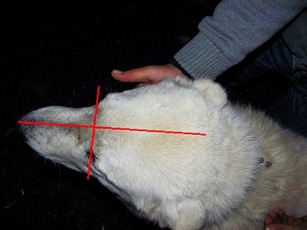
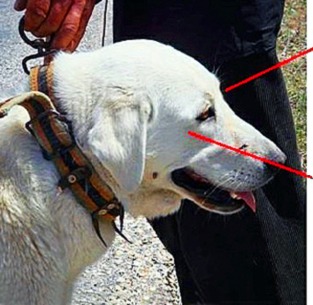

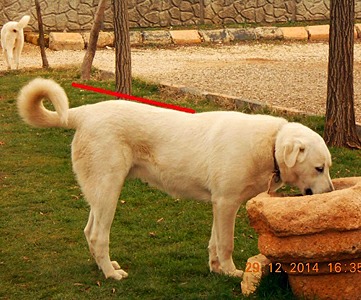

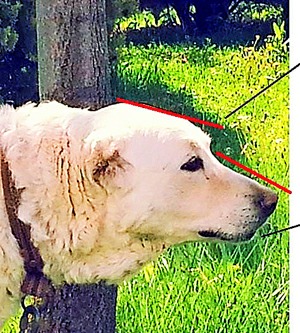

The topline rises slightly towards the croup.
Chest: Moderately wide and slightly convex, but never cylindrical. The depth is half of the height at the withers or slightly shorter.
TAIL: Moderately set tail forms a continuous line with the topline. Powerful at the base tapering gradually towards the tip. Carried low in repose with a hook at the tip preferred. It reaches at least as far as the point of the hocks. When the dog is alert, the tail is raised over the back in a circle. The circle must not fall on the side of the loin.
LIMBS:
FOREQUARTERS:
General Appearance: Parallel and muscular.
Shoulders: Powerful and moderately long. Forman angle of between 90˚ and 110˚. Strongly attached to the body.
Upper Arms: Well-muscled and almost as long as scapula.
Lower Arms: Strong and straight. Elbows form an angle of between 110˚ and 135˚. They are not to point in or out.
Pasterns: Vertically form an angle of between 20˚ and 30˚. Seen from the front, straight and parallel.
Forefeet: Roundish with powerful toes. Toenails are dark. Pawpads are elastic and strong. Darkly pigmented.
HIND ASSEMBLY:
General Appearance: Strong and parallel. Flexible in motion.
Thighs: Well-muscled and parallel. The length is about 30 % of the height at the withers.
Knees: The knee angle is between 110˚ and 130˚.
Lower Thighs: Well-muscled and parallel. The length is about 33 % of the height at the withers.
Hocks: Strong hocks are parallel, and vertical to the ground. Height of the hocks are 25-35 % of the height at the withers. Form an angle of between 120˚ and 155˚.
Rear Pasterns: Powerful, but flexible. The height of the pasterns is in harmony with the height of the hocks.
Rear feet: Face forward and parallel to each other. Slightly longer than the forefeet. Toenails are dark. Dewclaws are acceptable.
MOVEMENT: The Akbaş Dog walks calmly with the flock and prefers a trot of medium stride. Legs must cover maximum area with minimum energy. The head is carried either at the topline level or slightly above it. The topline must be firm during movement. Hindquarters must have a strong drive. Dogs that do not walk with ease and flexibility lose points regardless of how handsome they look.
SKIN: Tight to the body. Males may have a little dewlap. Skin must be completely or partially darkly pigmented. The visible skin on the nose, eye rims and lips must be either black or dark brown. The darker the better.
COAT: The body is covered with a straight double coat of between 4 to 7 cm. The coat is not as long as the breed’s European cousins. The underbelly is not covered with long hair. Short hair on the head and ears. The tail may have longer hair.
COLOR: Completely white. Biscuit and ivory on the ears or down the spine acceptable as long as they are not in patches.
HEIGHT AND WEIGHT:
Height: 67- 72 cm for males; 65-70 cm for bitches. Extreme sizes atypical for the breed type are detrimental for the breed’s working capacity and must be avoided.
Weight: Proportional to an athletic dog’s height.
FAULTS: Any departure from the foregoing points should be considered a fault and the seriousness with which the fault should be regarded is in exact proportion to the degree and effect upon the health and welfare of the dog.
SERIOUS FAULTS:
Head and expression atypical for the breed
Cumbersome or feeble dogs
Round or protruding eyes and those that are not set obliquely
Erect or not completely folded ears
Profuse or very short coat
Yellow eyes
Cow hocks
Wavy coat
DISQUALIFYING FAULTS:
Aggressive or overly shy dogs
Obvious behavioural or physical anomalies.
Missing or incomplete teeth (Except for M3, third molars and PM1 for premolars)
Monorchidism or cryptorchidism
Lack of undercoat
Docked tail
Height below the minimum
Under or overshot jaws
Albinism (Lack of pigmentation).
Blue or odd eyes
Coloured patches on the coat
N.B.:
Male animals should have two apparently normal testicles fully descended into the scrotum.
Only functionally and clinically healthy dogs, with breed’s typical conformation, should be used for breeding.
Akbash
Guardian Dog Group
Official UKC Breed Standard Revised April 1, 1998
The goals and purposes of this breed standard include: to furnish guidelines for breeders who wish to maintain the quality of their breed and to improve it; to advance this breed to a state of similarity throughout the world; and to act as a guide for judges. Breeders and judges have the responsibility to avoid any conditions or exaggerations that are detrimental to the health, welfare, essence and soundness of this breed, and must take the responsibility to see that these are not perpetuated. Any departure from the following should be considered a fault, and the seriousness with which the fault should be regarded should be in exact proportion to its degree and its effect upon the health and welfare of the dog and on the dog’s ability to perform its traditional work.
HISTORY
The Akbash Dog is a white livestock guardian breed native to the plains and mountains of western Turkey. While the origins of the breed are obscure, it is known to be an ancient pure breed. The Akbash Dog is the Turkish counterpart of the other white guardian breeds found around the northern Mediterranean Basin. However, only the Akbash Dog possesses its unique combination of Mastiff and gazehound characteristics. In Turkey, Akbash Dogs are owned and bred by villagers and shepherds to protect their sheep from wolves and other predators. Recognition of these great white guardians as a distinct breed resulted from fieldwork done by Americans David and Judy Nelson who studied the dogs in Turkey beginning in the 1970s. The Nelsons have imported over 40 Akbash Dogs to the United States. These dogs became the foundation stock for the breed in the United States and Canada. In 1980, the U.S. Department of Agriculture introduced Akbash Dogs to its Predator Control Program where the dogs performed successfully. The United Kennel Club recognized the Akbash Dog on January 1, 1998.
GENERAL APPEARANCE
The white Akbash Dog is a long-legged, lean, muscular dog of imposing size and strength, great courage, and stamina, with an alert, regal bearing. The Akbash Dog is slightly longer in proportion than tall, has a wedgeshaped head with pendant ears, and a long tail, usually carried in a curl over the back when the dog is moving or excited. The Akbash Dog represents a very rare and special mixture of Mastiff and gazehound characteristics that are important to maintain. The gazehound influence is apparent in the breed’s long legs, deep chest, arched loin, shallow lower jaw, tucked up flank, speed, and agility, while the Mastiff’s contributions can be seen in the breed’s height, weight, broader head, and overall impression of power. When judging this breed, preference should be given to Akbash Dogs who exhibit a perfect balance between the two types. Gender differences can be striking in this breed. Typically the dog is proportionately taller and heavier than the female. The bitch appears feminine in comparison to the dog. There is no difference in the ability of males or females to perform as guardians. The breed is presented in a completely natural condition and should be evaluated equally for correct conformation, temperament, gait, and structural soundness. Honorable scars or other evidences of injury resulting from working in the field are not to be penalized.
UKC AKBASH DOG BREED STANDARD
CHARACTERISTICS
The essential characteristics of the Akbash Dog are those
that enable it to perform successfully as a livestock guardian.
Akbash Dogs have the size, strength, and courage to
challenge large predators and the speed and agility to
chase fleet predators. Their temperament is calm, quiet,
and steady. They are independent and capable of correctly
responding to changing circumstances without human
direction. The Akbash Dog is also highly suitable as a
home companion or estate guardian. The Akbash Dog
is loyal, gentle, and quietly affectionate with its own family,
including children and family pets, but remains aloof and
suspicious toward strangers. It is also by nature watchful
of other dogs and may, on its own territory, react aggressively
to intruding dogs. Although independent in nature, the
Akbash Dog responds well to basic training. Properly
socialized and trained, the Akbash Dog is an ideal family
pet and home guardian.
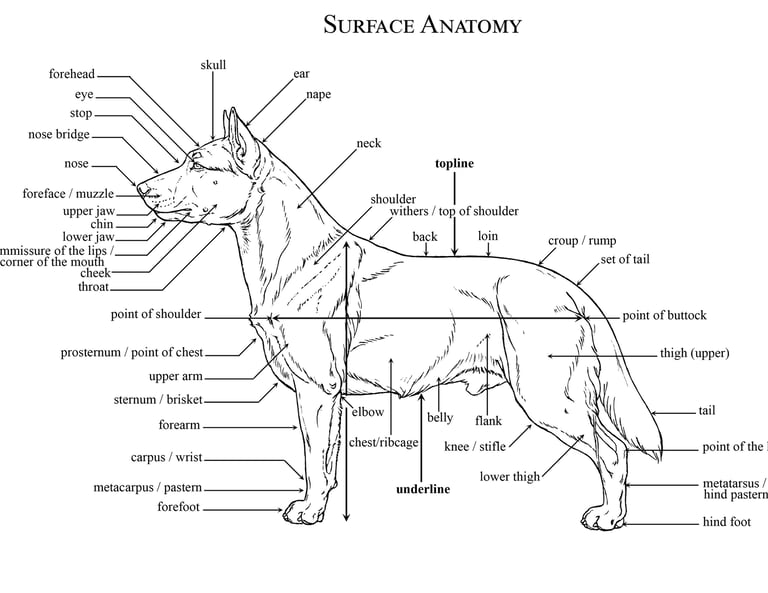

Although its protective, guarding instincts are demonstrated at a young age, the breed matures slowly, both physically and temperamentally, with individuals requiring two to three years to reach their prime. Females tend to mature faster than males.
HEAD
In both sexes, the wedge-shaped head is proportionate to the size and build of the individual specimen. The male head is proportionally larger than the female head. Viewed from above, the head tapers gradually toward the tip of the nose forming a blunt wedge shape. Viewed from the side, the length of muzzle is approximately one-half the length of the head, measured from occiput to nose. The head is free of wrinkles.
SKULL
The skull is large, slightly domed, and broad between the ears. The skull is longer than broad and tapers gradually toward the muzzle. The stop is slightly to moderately defined. The cheeks are flat and smooth.
Faults: Skull too flat; skull too narrow.
MUZZLE
Viewed from the side, the topline of the muzzle is straight and roughly parallel to the top of the skull. The muzzle is broad where it joins the skull and tapers gradually toward the nose, forming a blunt wedge shape. The jaws are strong but the lower jaw is relatively shallow. Lips are black or dark brown, flews are tight, and whiskers are white.
Faults: Snipey muzzle.
Disqualification: Complete lack of pigmentation on lips.
TEETH
The Akbash Dog has a complete set of large, evenly spaced, white teeth. A scissors bite is preferred, but a level bite is acceptable. Broken teeth resulting from field work are not to be penalized.
Serious Faults: Over or undershot bite; more than two teeth missing
NOSE
Nose color may be either solid dark brown or solid black, with both colors being equally acceptable. Dogs displaying a slight seasonal fading of nose pigment should not be penalized. The skin pigmentation of the muzzle around the nose may be gray, spotted, or absent but preference should be given to the stronger pigmentation. In profile, the nose is on the same line as the top of the muzzle and extends somewhat beyond the lower jaw. Serious Fault: Butterfly nose.
Disqualification: Complete lack of pigmentation on nose.
EYES
The eyes are medium-sized, almond-shaped, and set well apart. Eye color may range from golden brown to dark brown, with darker color preferred. Expression is intelligent, alert, and kindly. Eye rims are tight and solidly colored either black or dark brown. Eyelashes are white. Serious Faults: Very pale yellow eyes; loose eye rims.
Disqualifications: Blue eyes; complete lack of pigmentation on eye rims.
EARS
The ears are pendant, V-shaped, and slightly rounded at the tips. The ears are set rather high and lie flat to the skull. When alert, the ears are carried slightly higher; when the dog is disturbed, the ears are pulled back. When pulled toward the eye, the ear should extend at least to the outer edge of the eye and no farther than to the inner corner of the eye. In Turkey, the majority of Akbash Dogs have their ears cropped as puppies. Cropped ears on a dog imported from Turkey should not be penalized, but cropped ears on a domestic-bred dog are a disqualification. Faults: Ears set too high or too low; ears too large or too small.
Disqualification: Cropped ears on a domestic-bred dog.
NECK
The neck is muscular, medium-long to long, arched at the crest, with little or no dewlap. A dog with some dewlap should not be penalized. Fault: Excessive dewlap.
FOREQUARTERS
The shoulders are well muscled as expected in a working dog. The shoulder blade and upper arm are well angulated and nearly equal in length.
FORELEGS
The forearm is long, straight, and well boned in proportion to the overall build of the dog. The front legs are set moderately well apart with elbows close to sides. The strong pasterns are slightly sloping when viewed from the side. When viewed from the front, legs should be parallel with each other and perpendicular to the ground. Faults: Bowed front legs; feet that turn in or out.
BODY
The chest is deep and moderately wide. The ribs are well sprung from the spine and then flatten to form a deep body extending almost to the elbows. The length of the ribs decreases fairly quickly from the lowest point of the chest toward the loin. The topline inclines very slightly downward from well-developed withers to a strong back with a slight but definite arch over the loin, which blends into a long, well-muscled, sloping croup. The flank is well tucked up giving evidence of the gazehound influence in the breed.
Fault: Barrel chest.
HINDQUARTERS
The hindquarters are powerful. Although more heavily muscled, the bone and angulation of the hindquarters balances that of the forequarters.
HIND LEGS
The upper thigh is both deep, from front to back, and long. Stifles are well bent; hocks are well let down. The long hind legs contribute to the graceful arch of the loin and the speed and agility of the breed. Viewed from the rear, the rear pasterns are parallel to each other; from the side, they should be slightly forward of the perpendicular when the dog is in a natural but alert position.
Faults: Cow hocks; sickle hocks.
FEET
Two types of feet appear in this breed: cat feet and hare feet. Both are acceptable; the cat foot is preferred. Regardless of shape, the feet are large and strong with well-arched toes. The pads are thick, hard, elastic, and may be either light or dark. Nails are gray, brown, or white and should be presented blunt. Dewclaws may be absent, single, or double and may be removed.
Faults: Splayed feet.
TAIL
The tail is uncut, thick at the base, and tapering to the tip. The tail is set low at the base of the croup. When the dog is relaxed, the tail is carried low, just reaching to the hock, with the bottom third of the tail frequently forming a hook. When the dog is moving or excited, the tail is usually carried in a curl over the back. The height and degree of curl depends on the degree of excitement and confidence. The tail may be slightly to heavily feathered in proportion to the coat length of the dog. Faults: Docked or short tail; tail carried between the legs, which would indicate shyness or cowardliness.
COAT
The Akbash Dog has a double coat consisting of longer, coarse, outer guard hairs and dense undercoat made up of soft, fine hair. Thickness of the undercoat varies significantly with the climate and exposure of the dog to weather. The Akbash Dog normally sheds its undercoat annually. There are two equally acceptable coat lengths. No preference is given to either type. In both types of coat, the hair on the muzzle, ears, and paws is shorter than the body coat.
Medium Coat
The body hair is short to medium in length and lies flat giving a sleek, racy appearance to the dog. There is a slight ruff. There may be a slight feathering on the forelegs, thighs, and tail.
Long Coat
The body coat on the long-coated Akbash Dog is distinctly longer than on the medium-coated dog. The hair is often slightly wavy, but is never curled or matted. The long-coated Akbash Dog with full undercoat appears heavier than the medium-coated dog. There is a distinct ruff and profuse feathering on the forelegs, thighs, and tail. During the summer or in warm climates, the long-coated Akbash Dog appears significantly sleeker without the heavily developed undercoat.


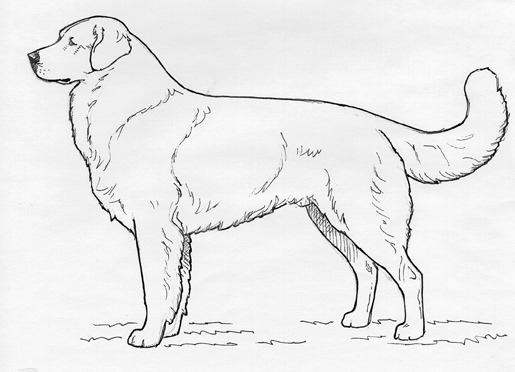

COLOR
The Akbash Dog is always white. Light biscuit or gray shading around the ears or in the undercoat should never be penalized as long as the dog’s overall appearance is white. Gray or silver-blue skin pigmentation, either solid or in spots, is desirable but not required provided the individual dog shows ample black or dark brown pigmentation on the eye rims, nose, and lips. Disqualifications: Any overall color other than white; defined spots on the outer coat; black whiskers; black eyelashes; albinism.
HEIGHT & WEIGHT
For this flock-guarding breed, size, soundness, and the ability to move with speed and agility are equally important. Desirable height at maturity, measured at the withers, ranges from 30 to 34 inches for males and 28 to 32 inches for females. Weight should be in proportion to the height, giving a well-muscled, lean appearance without being too light or too heavy. The average weight for a male Akbash Dog in good condition is 120 pounds; for a female, 90 pounds. Fault: Obese, soft condition. Severe Fault: Dog or bitch varying more than one inch in height from the parameters above.
GAIT
The gait of the Akbash Dog is easy, free, and elastic. The feet travel close to the ground. From the front or rear, the legs do not travel parallel to each other but rather close together at the ground. As speed increases, the legs gradually angle more inward until the pads are almost single tracking. Viewed from the side, the hind legs reach far under, meeting or even passing the imprints of the front legs. Unless the dog is excited, the head is carried rather low at the level of the shoulders. When alert, the Akbash Dog moves with determination and purpose toward the object of interest.
DISQUALIFICATIONS
(A dog with a Disqualification must not be considered for placement in a conformation event, and must be reported to UKC.)
Unilateral or bilateral cryptorchid.
Viciousness, marked shyness, or cowardliness.
Cropped ears on a domestic-bred dog.
Complete lack of pigmentation on the nose, eye rims, or lips.
Blue eyes.
Any overall color other than white.
Defined spots on the outer coat.
Black whiskers.
Black eyelashes.
Albinism.
Partnerships
Breeders and owners through education and collaboration.
contact@akbashdogs.org
Partners@AkbashDogs.org
© 2024. All rights reserved.
Supporting
Rescue
Rescue@AkbashDogs.org
